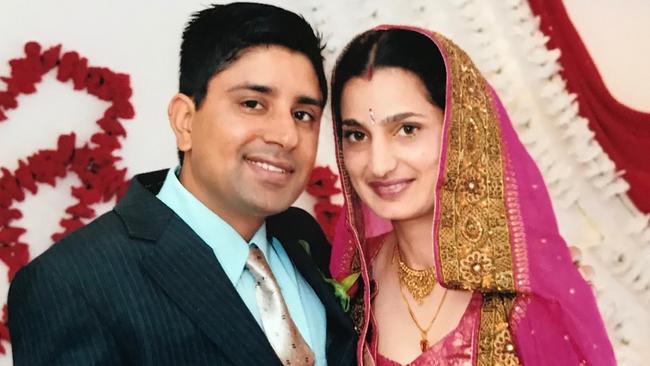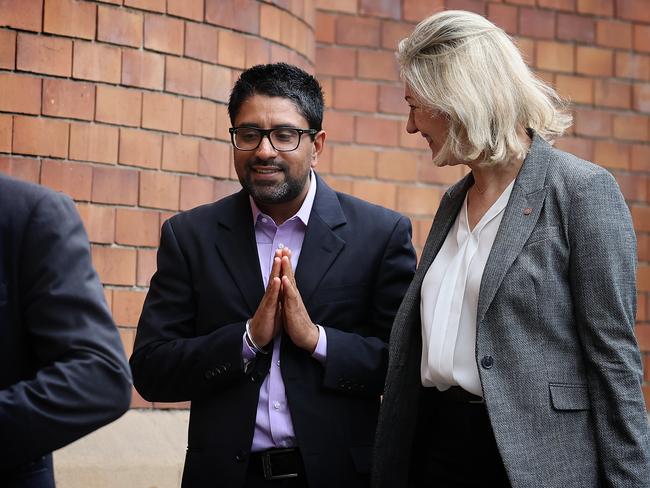Kulwinder Singh trial: Parwinder Kaur may have been inspired by movie to set herself alight, jury told
A jury will soon decide the fate of Kulwinder Singh, accused of pouring petrol on his wife and setting her alight at their Rouse Hill home.

NewsWire
Don't miss out on the headlines from NewsWire. Followed categories will be added to My News.
A woman may have been inspired to set herself alight by a movie in which a lady’s warring husband and birth family reunite around her hospital bed after she is accidentally shot by her father, a jury has heard.
A film with such a storyline was found in the DVD player of the Rouse Hill home where Parwinder Kaur, 32, suffered the serious burn injuries that killed her on December 2, 2013, the NSW Supreme Court heard on Monday.
Neighbours told the court they heard a bloodcurdling scream before seeing Ms Kaur engulfed in flames and her frantic husband Kulwinder Singh trying to pat them out in the driveway.
Two versions of what happened just prior to that awful moment have been presented to the jury tasked with deciding if Mr Singh is guilty of murder.
The first: Mr Singh set his wife alight as an escalation of his threats to leave the marriage, all part of his attempts to force her into financially contributing to mortgage payments.
The second: Ms Kaur set herself alight to “create a drama” that would stop her husband from leaving, not meaning to kill herself but making the fatal error of wearing an extraordinarily combustible cardigan.

Mr Singh’s barrister Margaret Cuneen said in her closing address on Monday that at the time Ms Kaur died, she was under financial pressure from her family and trying to aid in their visa applications.
Her husband was, not unreasonably, wondering where her wages were going, Ms Cuneen said.
The barrister suggested the film found in the DVD player “bore a striking resemblance to the happy if dramatic ending that (Ms Kaur) craved”.
Ms Cuneen told the jury “science doesn’t lie” and the evidence in the case pointed not to murder, but to Ms Kaur setting herself alight “with much greater consequences than she ever meant”.
Running through that evidence, Mr Cuneen said about a “teacup” of petrol was poured on Ms Kaur, and the can placed neatly back in the cupboard with about 1.25L left in it.
Only Ms Kaur’s fingerprints were found on the can and on a lighter, and the petrol was on her body for some 5-10 minutes before she was set alight, the court heard.

She had likely worn a towel on her head to protect her hair and face, and donned a thick cardigan -- despite the sweltering December day -- she hoped would protect her body, Ms Cuneen said.
But the knitted cardigan, made of acrylic rather than fire retardant wool, erupted catastrophically, an expert testified.
Ms Cuneen said no murderer would seek to protect his victim’s hair or face, nor carefully replace the unemptied petrol can in the cupboard.
She added that it made no sense Ms Kaur did not run from the house the second she was doused in petrol, nor mention it in a triple-0 call before she was set alight in which she said: “My husband nearly kill me.”
“It’s not Mr Singh who did this,” Ms Cuneen told the jury.
“It’s a conflicted, angry, anxious woman who is losing control.”
The barrister said “we all want to believe that people don’t tend to do terrible things to themselves” but in this case, that bias had influenced police and infected witnesses against Mr Singh.
Crown prosecutor Philip Hogan said Mr Singh and Ms Kaur had an “unhappy marriage” beset by financial problems.
He took the jury through bank account transactions he said indicated Ms Kaur’s wages were needed to meet mortgage payments. Calls between the couple were indicative of growing tension, he said.
Mr Hogan said Ms Kaur’s wages were regularly being paid into an account belonging to Mr Singh, but Ms Cuneen characterised it as a joint account for the mortgage payments.
Mr Hogan said that while Mr Singh had told “part-truths” to police in interviews, other parts of his story did not add up, including that he had been upstairs when he heard the scream and pelted down to find his wife alight.
This was contradicted by an eyewitness who placed him behind Ms Kaur at the time of the scream, meaning he must have lied, Mr Hogan said.
Mr Singh said she “did it in the laundry” but later said he didn’t know where she had set herself alight, the prosecutor said.
“He can’t get his version straight. The reason he can’t get his version straight is he’s not telling the whole truth.”
He said witnesses had told the court Ms Kaur was “a strong person, both physically and emotionally”.
“She had never talked about trying to harm herself. She was determined now she was going to leave him.”
He had already threatened her that he was going to leave, but by December 2, he knew that wouldn’t work because she wanted to leave him, Mr Hogan said.
“So he came up with another threat. And that threat was to pour petrol on her. And he did that as a threat to make her contribute financially. To make her stay in the marriage and try to recover money from her family.”
Mr Singh’s account, Mr Hogan said, “just doesn’t make any sense”.
He told the jury they had to draw their own conclusions on the forensic evidence.
Justice Natalie Adams will address the jury on Tuesday before they begin deliberations.
Originally published as Kulwinder Singh trial: Parwinder Kaur may have been inspired by movie to set herself alight, jury told



